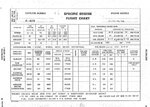Shortround6
Major General
Not debating it but where do you get 1410 hp @ 9,500 ft for the -81? And where do you get the altitudes for WEP ratings for the -39 and -73? My books just say 'Sea Level' for WEP. I'm always looking for new and more accurate sources.
I am getting most of the information from "Vees for Victory" by Danial Whitney. A history of the Allison engine
Wasn't 60" approved for later model P-40E / V-1710-39 as well as for the -73?
This one is subject to question, approved by who? sometimes the engine company and the Military did not agree. Sometimes the the engine company wanted to use higher ratings and sometimes the engine company didn't really want to approve WEP ratings ( Try and find WEP ratings in P & W company literature for example).
As far as the -39 goes, remember that the change to the nitrided crankshaft came part way through the production run, they did not change the model number of the engine.
Any -39 engine could make the level of power at 60in of MAP, the question was for how long? or how many times.
Is it true what some people are saying that Merlin XX had weak power down low?
That really depends on when. As in 1940 when first issued and the boost was limited to 9lbs (48in) or when it was cleared to use 12lbs boost or when it went to 14lbs in low gear and 16lbs in high gear. 14lbs is 58in (or close) and the Merlin XX (in British service) was rated at 1485hp at 6000ft no RAM, it may not have been cleared for 1600hp or so at sea level but 1485hp at 6000ft doesn't look too shabby to me.


 ...
... The P-40N-1
The P-40N-1